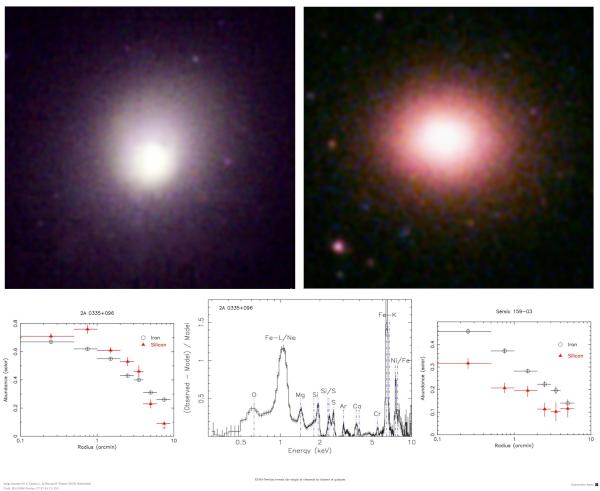XMM-Newton reveals the origin of elements in clusters of galaxies

Minimum credit line: Image courtesy of J.S. Kaastra, J. de Plaa and N. Werner, SRON, Netherlands and ESA. (for details, see Conditions of Use).
Credit: ESA/XMM-Newton, CC BY-SA 3.0 IGO
The image above can be displayed at full size and may be downloaded by clicking the image above.
| About this Image |
|---|
Upper panels show X-ray images of the clusters of galaxies 2A 0335+096 and SÚrsic 159-03 obtained with XMM-Newton EPIC cameras. Lower panels show the radial distribution of iron and silicon in these clusters and, in the central graphic, the line spectrum of the hot intra-cluster medium in the cluster 2A 0335+096, obtained in a deep 130 ks observation with the EPIC camera. While iron is produced mainly by type Ia supernovae, the silicon is produced by both supernova types. The distribution of silicon relative to iron is in these two clusters very different. The different radial distribution of iron and silicon show that these two clusters had a different evolution.
Investigator(s): J.S. Kaastra, J. de Plaa and N. Werner
| For More Information |
|---|
- Read the Press Release
- Detailed description of this image
- Query XSA archive for XMM-Newton data in the field of 2A 0335+096
- Astronomical database entries for 2A 0335+096;
- Query NED for more images about 2A 0335+096
- Query SIMBAD for more 2A 0335+096 data
- For unfamiliar terms, visit the XMM-Newton Astronomical Glossary
| Instrument | EPIC pn | ||
| Observing Mode | Full Frame | ||
| Filter | Thin | ||
| Date of Observation | 2004-02-04 | ||
| Image size | 25.00 x 25.00 arcmin | ||
| Detailed Caption | XMM-Newton observed two clusters of galaxies for one and a half day allowing a measure of their chemical composition with an unprecedented accuracy. Knowing the chemical composition of galaxy clusters has a crucial importance for the understanding of the origin of the chemical elements in the Universe. most of the atoms in clusters of galaxies are in the form of hot gas emitting X-ray radiation. There is about 5 times more mass in the hot gas than in galaxies. Most of the chemical elements produced in the stars of galaxy clusters which are expelled into the surrounding space by supernova explosions become part of the hot X-ray emitting gas. All the chemical elements in the universe except hydrogen and helium were produced in stars and blown out into the interstellar space by stellar winds and supernova explosions. Astronomers divide supernovae into two basic types: core collapse and Type Ia supernovae. The so called core collaps supernovae originate when a star at the end of its life collapses into a neutron star or a black hole. These supernovae produce lots of oxygen, neon and magnesium. The supernovae, called by astronomers Type Ia, explode when a white dwarf star consuming matter from a companion star becomes too massive and completely desintegrates. These supernovae produce lots of iron and nickel. The deep observations with XMM-Newton allowed astronomers to determine the abundances of 9 elements in the hot plasma of 2 clusters of galaxies (2A 0335+096 and Sersic 159-03). Fig. 2 shows the spectral lines of these elements and a chromium line seen in a galaxy cluster for the first time. Comparing the abundances of the detected elements to the theoretically calculated yields of supernovae they found that about 30% of supernovae in these clusters were exploding white dwarfs (Type Ia) and the rest were collapsing stars at the end of their lives (core collapse supernovae). This number is between the value found for our Galaxy (where the relative number of the Type Ia supernovae is ~13%) and the current relative frequencies determined by the Lick Observatory Supernova Search (about 42% of all observed supernovae are Type Ia). They also found that all supernova models predict much less calcium than what is observed in clusters and that the observed nickel abundance cannot be reproduced by these models. These discrepancies indicate that astronomers do not yet understand the details of supernova enrichment. Since clusters of galaxies are believed to be fair samples of the Universe, their X-ray spectroscopy can help to improve the supernova models. The spatial distribution of elements across a cluster also holds information about the history of clusters. The distribution of elements in 2A 0335+096 indicates an ongoing merger. The distribution of oxygen and iron across SÚrsic 159-03 indicates that while most of the enrichment by the core collapse supernovae happened long time ago, Type Ia supernovae still continue to enrich the hot gas by heavy elements especially in the core of the cluster. | ||
| Alternate Resolutions | (Help) |
|---|
This image is available in the following downloadable versions: Higher resolution versions of this image may be available, please contact the XMM-Newton HelpDesk.
Search the Image Gallery
To search the Image Gallery for a particular object, fill in the object name in the box below and click the Submit button.To search the Image Gallery for other images, fill in any of the fields below and click the Submit button.
For more search options, please use our Advanced Search form.